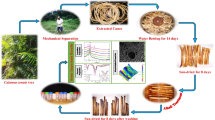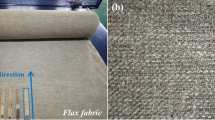Abstract
Woven cotton fabric was first modified with citric acid by a conventional pad-dry-cure process and then coordinated with Fe(III) ions to prepare a Fe(III)-modified cotton fiber complex. After the characterization by SEM, FTIR, XPS, XRD and DRS, this complex was used as a heterogeneous Fenton catalyst for the degradation of a typical textile dye, Acid Red 88, under visible irradiation. Some factors affecting the modification process, such as the citric acid and NaH2PO4 concentrations as well as the curing temperature, were also investigated with respect to the coordinating performance of the modified fabric and the catalytic activity of its Fe complex. The results indicated that cotton fabric could be esterified with citric acid to impart the carboxylic groups, which successfully reacted with Fe(III) ions to form the complex. Dye degradation was significantly accelerated by the presence of the complex under visible irradiation. Increasing the concentrations of citric acid, NaH2PO4 or the curing temperature enhanced the carboxyl group content of the modified fiber as well as Fe content and catalytic activity of its complex. However, an excessive amount of citric acid and NaH2PO4 or a curing temperature higher than 140 °C reduced the Fe content and catalytic activity of the complex. A higher initial H2O2 concentration promoted the dye degradation. The excellent catalytic and mechanical performance was also found in its reuse processes.













Similar content being viewed by others
References
Blanchard EJ, Reinhardt RM, Graves EE (1996) Factors affecting the dyeability of cotton crosslinked with polycarboxylic acid. J Soc Dyers Colour 112:108–113
Blanco J, Torrades F, Morón M, Brouta-Agnésa M, García-Montaño J (2014) Photo-Fenton and sequencing batch reactor coupled to photo-Fenton processes for textile wastewater reclamation: feasibility of reuse in dyeing processes. Chem Eng J 240:469–475
Buchert J, Pere J, Johansson L-S, Campbell J (2001) Analysis of the surface chemistry of linen and cotton fabrics. Text Res J 71:626–629
Budimir A, Vukusic SB, Flincec SG (2012) Study of antimicrobial properties of cotton medical textiles treated with citric acid and dried/cured by microwaves. Cellulose 19:289–296
Chattopadhyay D, Sharma D, De P (1999) Studies on formaldehyde-free crease-resistant finishing of cotton fabric using citric acid and selactive chemical adeditives. Indian J Fibre Text Res 24:284–289
Chi H, Xu K, Wu X, Chen Q, Xue D, Song C, Zhang W, Wang P (2008) Effect of acetylation on the properties of corn starch. Food Chem 106:923–928
Cotton AF, Wilkinson G, Gaus PL (1995) Basic Inorganic chemistry. Wiley, New York
Dhananjeyan MR, Kiwi J, Albers P, Enea O (2001) Photo-assisted immobilized Fenton degradation up to pH 8 of azo dye Orange II mediated by Fe3+/Nafion/Glass fibers. Helv Chim Acta 84:3433–3445
Dong Y, Wang J, Liu P (2001) Dyeing and finishing of cotton fabric in a single bath with reactive dyes and citric acid. Color Technol 117:262–265
Dong Y, Han Z, Liu C, Du F (2010) Preparation and photocatalytic performance of Fe(III)-amidoximated PAN fiber complex for oxidative degradation of azo dye under visible light irradiation. Sci Total Environ 408:2245–2253
El-Sawy NM, Ali Z (2007) Iron(III) complexed with radiation-grafted acrylic acid onto poly (tetrafluoroethylene-co-perfluorovinyl ether) films. J Appl Polym Sci 103:4065–4071
Fras L, Johansson L-S, Stenius P, Laine J, Stana-Kleinschek K, Ribitsch V (2005) Analysis of the oxidation of cellulose fibres by titration and XPS. Colloid Surf A 260:101–108
Gong R, Hu Y, Chen J, Chen F, Liu Z (2007) A cellulose-based carboxyl cotton chelator having citric acid as an anchored ligand: preparation and application as solid phase extractant for copper determination by flame atomic absorption spectrometry. Microchim Acta 158:315–320
Grace M, Chand N, Bajpai SK (2009) Copper alginate-cotton cellulose (CACC) fibers with excellent antibacterial properties. J Eng Fiber Fabr 4:24–35
Han Z, Dong Y, Dong S (2011) Copper–iron bimetal modified PAN fiber complexes as novel heterogeneous Fenton catalysts for degradation of organic dye under visible light irradiation. J Hazard Mater 189:241–248
Hartmann M, Kullmann S, Keller H (2010) Wastewater treatment with heterogeneous Fenton-type catalysts based on porous materials. J Mater Chem 20:9002–9017
Ishtchenko V, Huddersman K, Vitkovskaya R (2003a) Part 1. Production of a modified PAN fibrous catalyst and its optimisation towards the decomposition of hydrogen peroxide. Appl Catal A 242:123–137
Ishtchenko VV, Vitkovskaya RF, Huddersman KD (2003b) Investigation of the mechanical and physico-chemical properties of a modified PAN fibrous catalyst. Appl Catal A 242:221–231
Karthik T, Rathinamoorthy R, Murugan R (2012) Enhancement of wrinkle recovery angle of cotton fabric using citric acid cross-linking agent with nano-TiO2 as a co-catalyst. J Ind Text 42:99–117
Lewin M (2010) Handbook of fiber chemistry. CRC Press, Boca Raton
Li B, Dong Y, Li M, Ding Z (2014a) Comparative study of different Fe(III)-carboxylic fiber complexes as novel heterogeneous Fenton catalysts for dye degradation. J Mater Sci 49:7639–7647
Li B, Dong Y, Zou C, Xu Y (2014b) Iron (III)-alginate fiber complex as a highly effective and stable heterogeneous Fenton photocatalyst for mineralization of organic dye. Ind Eng Chem Res 53:4199–4206
Liu X, Tang R, He Q, Liao X, Shi B (2010) Fe(III)-loaded collagen fiber as a heterogeneous catalyst for the photo-assisted decomposition of Malachite Green. J Hazard Mater 174:687–693
Ma W, Huang Y, Li J, Cheng M, Song W, Zhao J (2003) An efficient approach for the photodegradation of organic pollutants by immobilized iron ions at neutral pHs. Chem Commun 13:1582–1583
Marshall WE, Akin DE, Wartelle LH, Annis PA (2007) Citric acid treatment of flax, cotton and blended nonwoven mats for copper ion absorption. Ind Crops Prod 26:8–13
Maulik SR, Das D, Bhattacharya S (2011) Concurrent dyeing and finishing of cotton with natural colour and citric acid in the presence of NaH2PO4 as catalyst under thermal treatment. J Text Inst 102:491–499
Moulijn JA, Van Diepen AE, Kapteijn F (2001) Catalyst deactivation: is it predictable? What to do? Appl Catal A 212:3–16
Muruganandham M, Swaminathan M (2004) Photochemical oxidation of reactive azo dye with UV–H2O2 process. Dyes Pigm 62:269–275
Oh SY, Yoo DI, Shin Y, Kim HC, Kim HY, Chung YS, Park WH, Youk JH (2005) Crystalline structure analysis of cellulose treated with sodium hydroxide and carbon dioxide by means of X-ray diffraction and FTIR spectroscopy. Carbohydr Res 340:2376–2391
Parikh D, Thibodeaux D, Condon B (2007) X-ray crystallinity of bleached and crosslinked cottons. Text Res J 77:612–616
Park H-J, Na C-K (2006) Preparation of anion exchanger by amination of acrylic acid grafted polypropylene nonwoven fiber and its ion-exchange property. J Colloid Interface Sci 301:46–54
Parra S, Nadtotechenko V, Albers P, Kiwi J (2004) Discoloration of azo-dyes at biocompatible pH-values through an Fe-histidine complex immobilized on Nafion via Fenton-like processes. J Phys Chem B 108:4439–4448
Pignatello JJ, Oliveros E, MacKay A (2006) Advanced oxidation processes for organic contaminant destruction based on the Fenton reaction and related chemistry. Crit Rev Environ Sci Technol 36:1–84
Reddy N, Yang Y (2010) Citric acid cross-linking of starch films. Food Chem 118:702–711
Schindler WD, Hauser PJ (2004) Chemical finishing of textiles. Elsevier, Amsterdam
Shao H, Sun J, Meng W, Qing F (2004) Water and oil repellent and durable press finishes for cotton based on a perfluoroalkyl-containing multi-epoxy compound and citric acid. Text Res J 74:851–855
Skårman B, Grandjean D, Benfield RE, Hinz A, Andersson A, Wallenberg LR (2002) Carbon monoxide oxidation on nanostructured CuO x /CeO2 composite particles characterized by HREM, XPS, XAS, and high-energy diffraction. J Catal 211:119–133
So C, Cheng M, Yu J, Wong P (2002) Degradation of azo dye Procion Red MX-5B by photocatalytic oxidation. Chemosphere 46:905–912
Soon AN, Hameed BH (2011) Heterogeneous catalytic treatment of synthetic dyes in aqueous media using Fenton and photo-assisted Fenton process. Desalination 269:1–16
Sun Y, Lin L, Deng H, Li J, He B, Sun R, Ouyang P (2008) Structural changes of bamboo cellulose in formic acid. BioResources 3:297–315
Wu K, Xie Y, Zhao J, Hidaka H (1999) Photo-Fenton degradation of a dye under visible light irradiation. J Mol Catal A 144:77–84
Xu W (2003) Effect of crosslinking treatment on the crystallinity, crystallite size, and strength of cotton fibers. Text Res J 73:433–436
Yang C (1991) FT-IR spectroscopy study of the ester crosslinking mechanism of cotton cellulose. Text Res J 61:433–440
Yang C, Wang X (1997) Infrared spectroscopy studies of the cyclic anhydride as the intermediate for the ester crosslinking of cotton cellulose by polycarboxylic acids. III. Molecular weight of a crosslinking agent. J Polym Sci A Polym Chem 35:557–564
Yang C, Wang X, Kang I (1997) Ester crosslinking of cotton fabric by polymeric carboxylic acids and citric acid. Text Res J 67:334–342
Zhu J, Gao Q, Chen Z (2008) Preparation of mesoporous copper cerium bimetal oxides with high performance for catalytic oxidation of carbon monoxide. Appl Catal B 81:236–243
Acknowledgments
The authors thanks the Tianjin Municipal Science and Technology Committee for the Research Program of the Application Foundation and Advanced Technology (11JCZDJC24600). This research was also supported in part by a grant from the Natural Science Foundation of China (20773093).
Author information
Authors and Affiliations
Corresponding author
Rights and permissions
About this article
Cite this article
Li, B., Dong, Y. & Li, L. Preparation and catalytic performance of Fe(III)-citric acid-modified cotton fiber complex as a novel cellulose fiber-supported heterogeneous photo-Fenton catalyst. Cellulose 22, 1295–1309 (2015). https://doi.org/10.1007/s10570-015-0562-x
Received:
Accepted:
Published:
Issue Date:
DOI: https://doi.org/10.1007/s10570-015-0562-x




